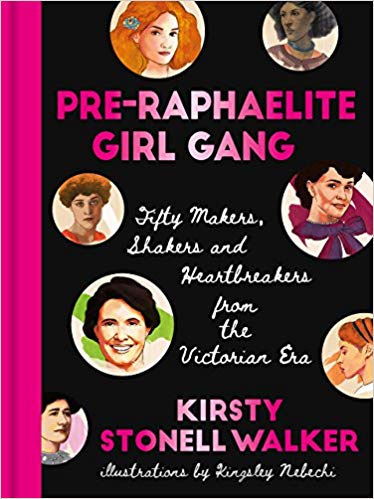
‘Pre-Raphaelite Girl Gang’ by Kirsty Stonell Walker.
Published by Unicorn.
Reviewed by William Rose.
This brightly coloured hardback contains a confection of research, playfulness and theatre. The lives of fifty women are described and examined and offered to the reader sometimes with a valuation and frequently in a way that encourages one. These are like theatrical vignettes. I can imagine short scenes in a theatrical production, each with their subject a “maker, shaker or heartbreaker”, in settings that would be familiar to them, often an artist’s studio, and wearing full Victorian dress, whilst the author narrates their stories.
These vignettes, though short and concise, usually around four or five pages, are full of the historical details, but can also stir the emotions. Anglaia Ionides is just one example: “…the beautiful and talented Aglaia”, who in the family house in Holland Park, “met the men with whom she wanted to work in partnership to create their artistic visions.” But Anglaia’s suicide was from a broken heart following the death of her daughter. She is one of the faces on the ‘Golden Stairs’ of Burne-Jones. Sadness and sometimes tragedy, weave their way through the lives of some of the fifty, along with survival, courage and success in adversity.
These are women who played their part in the great Pre-Raphaelite adventure, from its early clarity of light and colour and purity of vision, to the aesthetic androgyny of the Burne-Jones knights and ladies and the sumptuous, perfumed boudoirs of the loves of Rossetti. And amidst all, there is love, inspiration, scandal, anguish and early death. The Pre-Raphaelite circle lived sensually and unconventionally enough not to disappoint the art historians who at a later date would unravel some of their tangled relationships, and there is much here to play with; an approach in which Kirsty Stonell Walker excels, all underpinned by an encyclopaedic knowledge of her subject.
Of course there is the spiciness. On returning from the Burne-Jones exhibition at Tate Britain I went straight to the entry for Maria Zambaco – “Some women in history seem to come with a warning label….the notorious Mrs Maria Zambaco, sculptor and homewrecker.” What a telling picture ‘Phyllis and Demophoon’ is, with or without the whispy bit of cloth. I then did the proper thing and moved from the mistress to the wife, and what a remarkable woman Georgiana was with her political and social ideals; “self-effacing of her own talents but tireless in her support of others”. Good to see that she lived until eighty.
This is a book that you can read all the way through or dip into. Open any page and you have a Pre-Raphaelite Girl Gang member to think about on the day. You can also cross reference, and what a complex but fascinating diagram could be made from all those intersecting lives and their male counterparts. Presumably Rossetti would reside amongst a confluence of (sometimes incriminating) arrows. It is also a book that you can confidently give as a gift. It can appeal to anyone with imagination and a sense of humour and an interest in art, whatever their prior knowledge. It is thoroughly illustrated with the relevant portraits of the characters and the other paintings in which they appear: as the muse, the principal character, the adored one, or a player in the scene. Alongside of these are interesting contemporary portraits of each of the women by the artist Kingsley Nebechi.
This book is a celebratory claim for the spotlight that has so lit up the ‘Brotherhood’ to be shared by the sisters: models, muses, wives, lovers, and in many cases, though often downplayed or hidden, fine artists.
William Rose